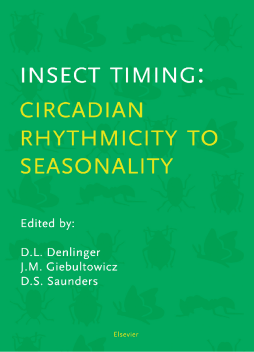
BOOK
Insect Timing: Circadian Rhythmicity to Seasonality
D.L. Denlinger | J. Giebultowicz | D.S. Saunders
(2001)
Additional Information
Book Details
Abstract
Leading experts in the field bring together diverse aspects of insect timing mechanisms. This work combines three topics that are central to the understanding of biological timing in insects: circadian rhythms, photoperiodism, and diapause. The common theme underlining each of the contributions to this book is an understanding of the timing of events in the insect life cycle. Most daily activities (emergence, feeding, mating, egg laying, etc.) undertaken by insects occur at precise times each day. Likewise, seasonal events such as the entry into or termination from an overwintering dormancy (diapause) occur at distinct times of the year. This book documents such events and provides an up-to-date interpretation of the molecular and physiological events undergirding these activities.
The study of circadian rhythms has undergone a flowering in recent years with the molecular dissection of the components of the circadian clock. Now that many of the clock genes have been identified it is possible to track daily patterns of clock-related mRNAs and proteins to link the entraining light cycles with molecular oscillations within the cell. Insect experiments have led the way in demonstrating that the concept of a "master clock" can no longer be used to explain the temporal organization within an animal. Insects have a multitude of cellular clocks that can function independently and retain their function under organ culture conditions, and they thus offer a premier system for studying how the hierarchical organization of clocks results in the overall temporal organization of the animal. Photoperiodism, and its most obvious manifestation, diapause, does not yet have the molecular underpinning that has been established for circadian rhythms, but recent studies are beginning to identify genes that appear to be involved in the regulation of diapause. Overall, the book presents the rich diversity of challenges and opportunities provided by insects for the study of timing mechanisms.
